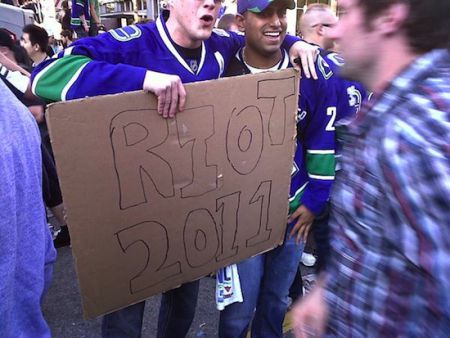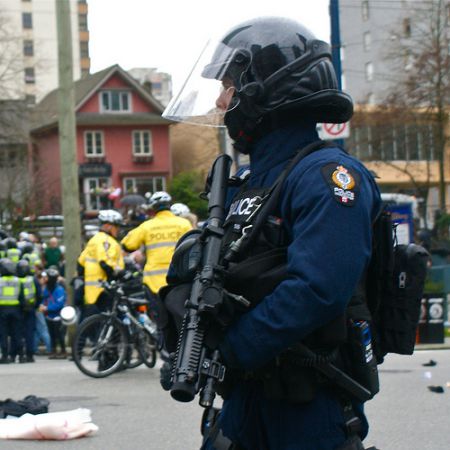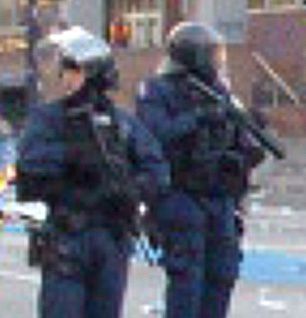STORY about Police/Prisons posted on September 5, 2011 by Zig Zag
Report Recommends Repression to Reign in Canuck Rioters
Also posted by Zig Zag:
Also in Police/Prisons:
The official report on the June 15 Canuck's Riot was released on Sept. 1, with the odd title “The Night the City Became a Stadium.” Costing more than $313,000, the report was co-written by Douglas Keefe, a former deputy minister in Nova Scotia, and John Furlong, former head of the Vancouver Organizing Committee for the 2010 Olympics (VANOC). A total of 53 recommendations are made, with the goal of avoiding any repeat of the rioting that occurred following the Canucks Game 7 loss to the Boston Bruins in the 2011 Stanley Cup Finals.
The report blames alcohol consumption, massive crowds, and police disorganization as the main factors contributing to the riot, which saw millions of dollars in damages and looting in downtown Vancouver, including 17 vehicles set on fire (two of which were police cars).
Massive Crowds of Alcoholics Arrived Early
According to the report, there were some 150,000 people in the downtown core on June 15, five times larger than the estimated capacity of the city-run public viewing areas. The Live Site venues, where massive TV screens were erected to broadcast the games, were estimated to hold about 34,000 people. The massive crowds arrived earlier than anticipated, hindering the efforts of police to deploy and carry out alcohol screening on transit and the streets. According to the report, the police were simply overwhelmed.
In a technical appendix to the report, written by Ottawa deputy police chief Charles Bordeleau and Inspector Mark Ford, it is also noted that Vancouver police initially opposed the Live Site venue locations and preferred that they be moved outside of the downtown area. The city insisted they stay downtown, and the Vancouver Police Department (VPD) developed security plans based on this.
Yet, in the same appendix, it is noted that security at the Live Sites had “significant gaps.” Two private security firms, Concorde and brand.LIVE, were employed to screen people entering the sites, primarily for alcohol. The appendix asserts that Concorde guards were not trained to check for alcohol, and that city officials wrongly assumed that the private security personnel were checking for alcohol.
This is part of the overall thrust of the report itself, which is that “If alcohol consumption could have been controlled... we believe there may not have been a riot.”
One recommendation is that “The powers of the... Liquor Control and Licensing Branch should be reviewed to consider additional powers to dampen the sale and distribution of alcohol for regional events.”
As it was, downtown liquor stores were in fact closed during the day of the final Game 7, a policy the VPD had urged following disturbances earlier in the series. At the Live Sites, the security were indeed searching people for alcohol and this was why I myself did not enter any of these 'zones'. And how much 'training' does it take to search a person and their bag for alcohol?
While alcohol was certainly a contributing factor, being an essential part of the corporate hockey culture, it is also being used as a smokescreen to obscure the reality of increasing levels of social tension (even if it manifests in ways that are not 'politically correct' or are seemingly 'without reason'). While alcohol may have emboldened the youthful rioters, many clearly set out with the intention of rioting.
Police Deployment and Joint Training
For the first time, the numbers of police deployed on June 15 was disclosed. Until now, this was kept secret as part of 'operational security' and became a minor public controversy in its own right. According to the report, 446 officers were on the streets when the rioting began. This number swelled to 928 later in the evening as additional cops were brought in from surrounding RCMP detachments in Burnaby, Richmond, and Surrey, as well as municipal cops from Delta, Abbotsford, etc.
A mantra that has been repeated by officials is that there were “too many people, not too few police,” and that no amount of police could have effectively controlled such a large crowd. It is likely that future crowd control situations will attempt to minimize crowd sizes or more effectively disperse them (as police initially sought to do during the playoffs, according to the appendix written by the cops).
One recommendation in the report is that “The RCMP tactical troop and VPD's public order unit [the crowd control units] should train together and develop common tactics they can use as a unit during joint operations.” The technical appendix goes a step further, recommending that provincial and national standards be developed for crowd control tactics.
The Arwen: Banned for Crowd Control?
In the technical appendix written by Bordeleau and Ford, there is an interesting reference to the use of a prohibited weapon by Vancouver police during the riot: the Arwen (Anti-Riot Weapon), a less-lethal rifle that fires a variety of rounds including plastic or rubber batons, pellets, bean bags, pepper spray, etc.
The Arwens in question were reportedly carried by the Emergency Response Team (ERT) members deployed with the public order unit. Senior police commanders as well as unit commanders claimed to be unaware that the ERT members had the weapons and had not authorized their use.
The VPD had used the Arwen during the 1994 Stanley Cup Riot, badly injuring Ryan Berntt when he was hit in the head with a baton round. Berntt was in a coma for several weeks and later tried (unsuccessfully) to sue the VPD for damages. Following this, the VPD changed its policy on the use of the Arwen and prohibited it from being used in crowd control situations. The ERT retained use of it for other incidents.
This note in the appendix is not mentioned in the overall report, and raises several questions. The Arwen is commonly carried by the VPD public order unit when they are deployed during protests in the city. Sometimes they appear to be carried by ERT members, whose uniforms are usually distinguished from regular patrol officers by the use of subdued (black) shoulder insignia.
During the Feb. 13, 2010 'Heart Attack' protest during the Olympics, members of the VPD public order unit are clearly seen carrying Arwens.
During the Canucks riot, I personally observed the use of Arwens by the public order unit, repeatedly firing into the crowd. These weren't baton rounds, however, but small foam projectiles.
During and since the Olympics, members of the public order unit have also appeared with M4 carbines (shorter versions of the M16A2), presumably carrying less-lethal rounds.
It may be that ERT members attached to the public order unit simply wear the same uniforms and insignia. As such, they are effectively members of the unit and take commands from the unit commander. It would be impossible for an officer to appear in formation armed with an Arwen and not be seen to be doing so by a unit commander, never mind firing it into crowds. If it has been VPD policy to not deploy Arwens for crowd control, then they have been violating their own rules for many years now.
The technical appendix to the report recommends that the Arwen should have been pre-authorized by 'Silver Command', a tactical-level inspector with overall responsibility for the police during the riot. According to the logic of the authorities, when rules are broken, should not the violators be punished?
Hunt for Rioters Continues
Shortly after the riot, the VPD along with other regional police established the Integrated Riot Investigation Team (IRIT), comprised of some 24 investigators with additional researchers and analysts.
Following the large-scale rioting in England in early August, the VPD were criticized for the long delay in laying charges against riot suspects. In England, over a thousand had been arrested and charged in a matter of days after the rioting began. In contrast, the VPD have yet to lay any charges two a half months after the Canucks riot, even though 51 have already turned themselves in after being identified online or on TV news (an additional 1,100 names of suspects have been provided, according to police).
The VPD claim they are simply being thorough in their investigation. Their rationale is that although people may admit to a 'criminal act', there may be others they committed (that is, they confess to a lesser charge in order to avoid further investigation into their case).
An additional factor in the delay in laying charges is that some 1,600 hours of footage has been sent to the National Digital Multi-media Evidence Processing Lab at the University of Indianapolis.
In late August, the VPD set up a website featuring photos of 40 people allegedly participating in the riot (riot2011.vpd.ca). Days later, six of these reportedly turned themselves in, while 3 were identified by the public. Police stated the site had over 100,000 visitors four days after it was set up, with some 225 tips being provided. An additional 100 photos are to be posted in the weeks following.
The VPD web site is in addition to sites set up by vigilante citizens immediately following the riot, who scoured through social media for photos, videos, and incriminating statements made by alleged participants in the riot. One of these, the Vancouver Riot Pics group on Facebook, set up by Robert Gorcak, claims to have identified 300 suspects.
The VPD also acquired the use of ICBC's (the Insurance Corporation of BC) facial recognition software, which is used in the production of driver's licenses and BC identity cards.
As noted, the VPD has sent some 1,600 hours of video footage to the National Digital Multi-media Evidence Processing Lab. There, software is used to identify certain individuals by parts of their clothing, hair style, etc., and searches through photos and videos for additional images of the person. The VPD utilized a similar system following the 1994 hockey riot.
One of the recommendations of the Furlong and Keefe report is that “The Attorney General should establish a process or special court specifically for dealing with the prosecution of people accused of a riot related criminal act...”
Conclusions and Recommendations
The official report on the Canucks Riot of 2011, not surprisingly, absolves the city, corporations, and police of any responsibility for contributing to the riot. While not diminishing the important aspects of social conflict that were manifested in the rioting, it is clear that the event itself was organized by the city, corporations and cops: it was their event, their venues, and their Live Sites that provided the terrain of struggle. The provincial government even sold the alcohol that is now being blamed for fueling the riot.
The only thing the authorities did not control was the people in the streets, a fact that should by itself be cause for celebration. These were not the pseudo-fascist mobs that spewed out of downtown bars during the 2010 Olympics, all dressed in patriotic blood red. Instead, it was a rebellious mob of Canucks fans who ruthlessly attacked and looted corporate property, committed numerous arsons, and fought with riot police. Even police and city officials have admitted it was a very different crowd than that seen during the Olympics.
Accordingly, the report recommends methods for more effective crowd control in the future, including greater dispersal of crowds, bans on alcohol sales, and joint training of regional police forces. It is most certainly the sheer scale of destruction that occurred and the jubilant participation by thousands of people that has authorities scrambling to find more effective methods of suppressing such disturbances, while also appearing to be successful in identifying and punishing those that did participate.
While I myself have many recommendations arising from the 2011 Canucks Riot, I will share just two:
1. The widespread use of social media, photographs, and video to identify riot suspects underscores the necessity of concealing one's identity if engaging in such nefarious acts. Today, there are as many cameras in the streets as there are people (carrying cell phones with cameras), in addition to the widespread use of digital cameras, CCTV surveillance cameras, etc.
2. Posting incriminating statements, photos and videos is something you do when you're stupid; try not to be stupid.
To read the report in full, check out vancouver.24hrs.ca/riotreport
The site for the Vancouver local of The Media Co-op has been archived and will no longer be updated. Please visit the main Media Co-op website to learn more about the organization.


